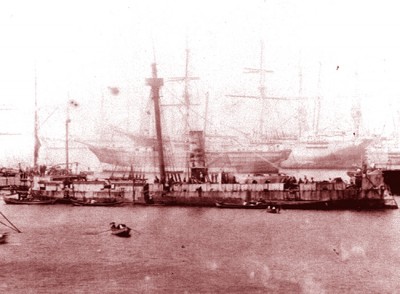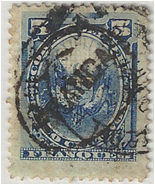ALBUM – view my Chiclayo, Chilean occupation of Peru album
Fast Facts
Region: South America
Group: Chilean Occupation of Peru
Classification: Military Occupations
Prior Regime: Republic of Peru
Key Dates:
1879, Apr 5 – Chile declares war on Bolivia and Peru.
1881, Jan 17 – Chilean troops enter Lima
1883, Jul 10 – Peruvian resistance fighter were defeated at the Battle of Humachurco
1883, Oct 20 – Chile and Peru signed the Treaty of Ancón
1884, Aug – Chile removes the last occupying forces from Peru.
1885, Dec 12 – Civil war ends with the defeat of Miguel Iglesias
Following Regime: Republic of Peru
Scott Catalogue: (Peru, Occupation Stamps, Chiclayo) #7N1-7N2
Pick Catalogue: none
Currency: Sol = 100 Centavos 1863-1901, Inca = 10 Soles = 1.000 Reales, 1880-1882
History

 The first battles of the war were fought on the sea. At the Battle of Iquique (then in Peru, now in Chile), on 21 May, 1879, the Peruvians suffered the loss of one of their best warships, the Independencia; the Huáscar was then sunk on 8 October, and this eventual surrender of control of the sea permitted a Chilean army to land on the Peruvian coast.
The first battles of the war were fought on the sea. At the Battle of Iquique (then in Peru, now in Chile), on 21 May, 1879, the Peruvians suffered the loss of one of their best warships, the Independencia; the Huáscar was then sunk on 8 October, and this eventual surrender of control of the sea permitted a Chilean army to land on the Peruvian coast.
On land, the Chilean army bested the badly equipped Bolivian and Peruvian armies, leading to Bolivia’s complete defeat and withdrawal in the Battle of Tacna on 26 May, 1880, and the defeat of the Peruvian army after the Battle of Arica on 7 June, 1880. Chilean forces continued to advance, and on 17 Jan, 1881, Chilean forces captured Lima, the capital city of Peru.
With Chilean Occupational forces in control, the national government in Peru was in turmoil. The President of Peru, Nicolás de Pierola escaped Lima, and eventually fled to Europe. While a provisional president was appointed in Lima, Garcia Calderon, he was eventually removed and imprisoned in Santiago and Chile continued the campaign to subjugate Peru. Peruvian resistance arose across the country, encouraged by the U.S., under the leadership of General Andrés Cáceres (the Warlock of the Andes). Initially, the Peruvians were able to inflict damage on Chilean forces, however on 10 July, 1883 at the Battle of Humachurco, Peruvian resistance forces were substantially defeated.
Even though Cáceres tried to regroup, a Peruvian government headed by Miguel Iglesias signed the Treaty of Ancón (October 10, 1883), recognizing defeat and bringing an end to the war. In the treaty, the Peruvian province of Tarapacá would be ceded to the Chile, the provinces of Tacna and Arica would be administered by Chile for 10 years, after which a plebiscite would be held to determine its future sovereignty.
After the war, Cáceres refused to recognize Iglesias as president so a civil war broke out between these two factions. Eventually, Cáceres attacked Lima on 28 Nov, 1885, forcing Iglesias to resign on December 12th. The country was ruled by a Council of Ministers headed by Antonio Arenas while new elections took place. Running for the Constitutional Party, Cáceres won the elections as sole candidate and assumed as president on 3 Jun, 1886.
Stamps
 ALBUM
ALBUM
During the war, Chilean forces primarily occupied the two largest cities in Peru, Lima & Callao, and overprinted stamps were issued by the occupational government. As these cities were the source of supply of postage stamps, Peruvians in Chiclayo, along with other major cities (Ancachs, Apurimac, Arequipa, Ayachucho, Chachapoyas, Chala, Cuzco, Huacho, Moquegua, Paita, Pasco, Pisco, Piura, Puno an Yca ) were forced to make provisional issues from whatever material was at hand. Many of these were former canceling devices re-purposed for this.
Chiclayo issued two stamps in 1884, during the Chilean civil war which followed the War of the Pacific. Both were 5c Peruvian stamps, one was overprinted with the words “FRANCA” within a large oval, and the second lacked the oval. When the country stabalized, standard Peruvian stamps were used.
Banknotes
No specific banknotes from Chala were issued.
Links
War in the Pacific by Andrew Clem
War of the Pacific
Chilean Occupation of Peru Overprints




